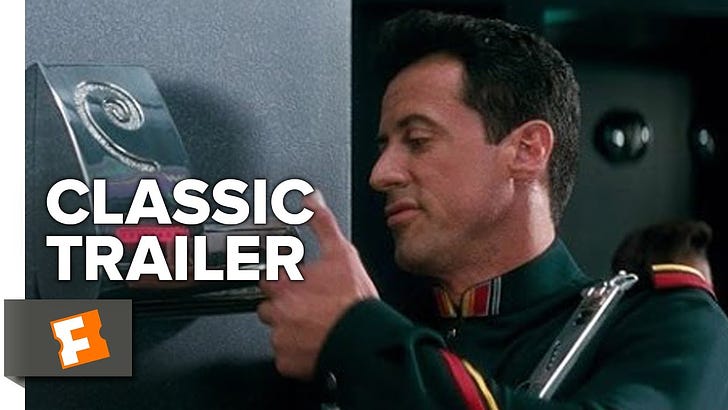Long-time readers know the tone and tenor of this vapid blog veers dark and depraved. But these days the world contains enough darkness and depravity to last a thousand lifetimes. We can all use a break from the doom and gloom sometimes, so this week I cooked up a (mostly) fun and fast-paced field guide on how to create a cult classic movie.
And there’s no better template to study than one of the twentieth century’s most influential films: Demolition Man1 (1993).
Before we analyze the magic ingredients which go into crafting a cult classic, let’s establish two ground rules.
First, every great movie requires a taut, efficient screenplay, superb direction, outstanding cinematography, and inspired performances. These essentials are implied, which means this Field Guide will focus on the subtler elements which take a film from great to legendary.
Second, I’ve never studied film, never made a film, never written a screenplay, and am generally full of shit.
Let’s begin.
First ingredient: create unforgettable characters, with unforgettable names
Ripley, Hicks, Hudson, Newt, Bishop.
Dutch, Dillon, Hawkins, Poncho, Billy.
Snake, Hauk, Cabbie, Brain, The Duke.
Unforgettable films have unforgettable characters. When you see those names the movie in question immediately springs to mind.
Now consider Demolition Man.
Our hero is legendary LAPD Sergeant John Spartan, A.K.A. The Demolition Man, who’s played by Sylvester Stallone at his peak.
Spartan’s arch-nemesis is the psychopathic killer Simon Phoenix, brought to life by an equally game Wesley Snipes.
Sandra Bullock delivers comic relief and sexual tension as Lieutenant Lenina Huxley — a fun, if unsubtle, homage to Brave New World — while Nigel Hawthorne plays the duplicitous Raymond Cocteau (emphasis on “cock”) and Denis Leary does Denis Leary things as the rebellious anti-hero Edgar Friendly.
All these indelible characters are fully formed, though Snipes’ Phoenix holds a special place in my heart. I named a key character in my novel after him and, to this day, whenever I need to stay incognito I use his moniker as my fake name of choice.
Pro tip: If you cast future U.S. Governors (e.g., Reagan, Schwarzenegger, Ventura) your film’s staying power increases exponentially (e.g., Knute Rockne All American, Predator, The Running Man).
Second ingredient: kick off with a bang
Demolition Man’s opening frames are pitch perfect. First, the camera pans over the world-famous “HOLLYWOOD” sign engulfed in flames, then the words “Los Angeles” and “1996” are overlaid on the screen. All while a relentless barrage of sirens drown out the ominous score.
This is fantastic world-building. In seconds the viewer knows this dystopian version of Los Angeles is almost as terrifying as Fox News’ present-day depictions of Chicago.
The first line of the film, uttered by an LAPD helicopter pilot, reinforces the scale of the devastation:
“Remember when they used to let commercial airlines land in this town?”
From there Spartan singlehandedly bungee cords from the helicopter into the urban warzone and starts taking out people of color — who we all know are intrinsically violent — until he works his way to the plot-establishing, mano a mano, when-men-were-goddamned-men showdown with Phoenix.
As smart booking dictates, babyface Spartan bests heel Phoenix on a level-playing field, which reinforces his moral and physical superiority. Then, in the critical moment, with Spartan inquiring one last time about the location of the kidnapped hostages, the following exchange takes place:
Where are they, Phoenix?!
Now where did I put ‘em? I swear, I’d lose my head if it wasn’t attached.
I’ll keep that in mind.
Remember this dialogue, because it comes full circle.
Of course, in a film called Demolition Man it would be amoral for a building not to explode at the end of the opening sequence, ergo a building explodes.
For other excellent examples, check out the harrowing “manhunts” in Hard Target (1993) and Avenging Force (1986), and the bank heist at the beginning of The Dark Knight (2008).
Finally, while I love when films open with an action set piece, they’re not required. Predator (1987), which for my money is still the greatest action movie ever made, eases in with some surprisingly slow plot exposition. Then again, this happens:
Third ingredient: be topical, yet prescient
For a cult classic to stand the test of time, it has to be relevant when it’s released and when viewed by future audiences.
Demolition Man achieves this in spades. In fact, this movie was so prescient somebody much smarter and way more motivated than me should write a book about it. I’m looking at you, Professor Amy Letter.
For this Field Guide, I’ll focus on three specific issues.
First, police brutality.
At the twenty-six minute mark of the film the newly augmented and freshly escaped Phoenix, who’s been cryogenically frozen until the year 2032, confronts a group of six police officers.
In Demolition Man’s dystopian view of the future, society has been pacified and violence has been eradicated. This means the police are not at all equipped to deal with Phoenix’s nineties-inspired viciousness.
His swift and forceful beatdown of the cops prompts this infamous line from Rob Schneider’s police dispatcher:
“We’re police officers! We’re not trained to handle this kind of violence!”
It’s a killer line.
But there’s also a grim inversion of reality at work which, given the background music and general zaniness of the scene, the filmmakers clearly enjoyed interrogating. Just two years prior, in March 1991, video footage of the LAPD’s violent assault of Rodney King had shocked the nation.
For the 1993 viewer, the film presents a macabre reflection of that horrific event, with a lone Black man brutalizing six “defenseless” police officers.
For the 2023 viewer, this sickening inversion still holds. For example, the Memphis PD’s grotesque murder of Tyree Nichols in January proves this social commentary remains disgustingly topical.
Second is the pervasiveness of the surveillance state. Some 1993 viewers might’ve seen all those digital toys and handheld devices and envisioned a future technological utopia. The more leery and better read viewers would’ve recognized the ham-handed clear-eyed connections to Huxley and Orwell.
And yet, in 2023, most of us humans willingly carry devices that track our every move, and listen to everything we say.
Finally, and most broadly, Demolition Man looks at the concept of government overreach, and the restriction of freedoms which could be imposed by a so-called “Nanny State.”
At the time, these concerns stemmed from the “Political Correctness” movement, which many feared would curtail free speech and freedom of expression. This provides the basis for Friendly’s rant in the second half of the film, which reveals he’s not a criminal mastermind but more so a “critical thinker, bro.”
A fitting present-day analogue is the great state of Florida. A place that loves freedom so much the local government tells its citizens exactly what they’re allowed to read and precisely what they’re supposed to think.
Regardless of political ideology, scumbags on the extreme fringes love nothing more than curtailing individual freedoms, and Snipes’ Phoenix puts it best when he tells Cocteau:
“Look, you can’t take away people’s right to be assholes.”
Demolition Man pokes at life’s fascinating and timeless questions, which is why it remains relevant.
Fourth ingredient: embrace one-liners
Look, for a cult movie to achieve cult status it must deliver memorable and quotable lines. Full stop.
You hear “I’ll be back” and you think The Terminator (1984). Schwarzenegger built his entire acting career around that film and eventually rode his fame to become Governor of California. By the way, Demolition Man predicted he’d become U.S. President after the passage of the Sixty-First Amendment.
Anyway, in the film’s sterilized version of San Angeles language has been fully neutered, which generates a smorgasbord of hilarity.
Some of my personal favorites, which I’ve now been using for three decades, include:
“Enhance your calm,” which I say to myself every time something in my money pit of a condo breaks.
“What seems to be your boggle?” I troll my wife and kids with this one after I intentionally antagonize them.
“Be well,” which I append to most of my fatalistic takes about the world, and also include at the bottom of the email people receive when they unsubscribe.
Finally, “Send a maniac to catch a maniac” bookends the opening and closing of the film, and is generally a great life motto. I murmur this to myself every time I pick up my kids from school.
Fifth ingredient: close the loop
Proper classics bring the narrative full circle, close with a bang, and send the audience home satisfied.
Remember that exchange between Spartan and Phoenix?
In their final confrontation, in the collapsing cryoprison, there’s a crucial callback to the opening scene. At the beginning of the film, Phoenix cheekily asks Spartan, “Is it cold in here, or is it just me?” right before he sets the building ablaze. This leads to the explosion and the wrongful manslaughter charges which see Spartan cryogenically imprisoned alongside Phoenix for nearly four decades.
Fast-forward to the climactic battle and Spartan asks Phoenix the exact same question, which elicits the response, “Good memory.” From there, both men obviously engage in masculine, heteronormative violence — the answer to all of humanity’s problems — until Spartan delivers the coup de grâce.
And, you guessed it, Phoenix loses his head.
Other incredible endings
In Predator, we first meet Dutch sitting in a helicopter and smoking a cigar — the apex of masculinity. When the film ends, he’s also sitting in a helicopter, but this time he’s broken and beaten down, having more than met his match at the hands of the eponymous antagonist (protagonist?).
In Aliens (1986), the dynamic’s inverted. After surviving her first encounter with a xenomorph in Alien (1979), Ripley emerges from hypersleep emotionally fragile and psychologically scarred. By the end, she goes back into hibernation as the baddest woman in the galaxy2.
Finally, one of my all-time favorites is the conclusion of Escape from New York. Snake agrees to the suicide mission — ostensibly to rescue the President, save his skin, and prevent World War III — and against all odds survives. When he’s subsequently blown off by the same President he risked his life to save, Snake realizes he was just another expendable asset, and sabotages humanity’s future in a fit of nihilistic pique.
By the way, that’s totally what I’d do.
For space considerations, I’ll stop here. But hopefully you enjoyed this look at some of the key elements which underpin our favorite films.
If anyone has additional takes, let’s riff in the comments.
Watch these
Here are a dozen cult classic films which will make you a more interesting and well-rounded person.
This list is by no means exhaustive, so please share your favorites in the comments.
Enter the Dragon (1973)
Assault on Precinct 13 (1976)
Escape from New York (1981)
Aliens (1986)
Big Trouble in Little China (1986)
Predator (1987)
The Running Man (1987)
Hard Target (1993)
Blade (1998)
Brotherhood of the Wolf (2001)
Snowpiercer (2013)
Mad Max: Fury Road (2015)
Spoilers throughout. If you haven’t seen Demolition Man, fix your life.
I saw Aliens on the big screen last weekend because my life’s the bomb.








